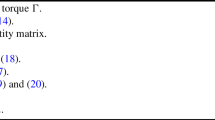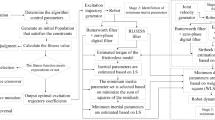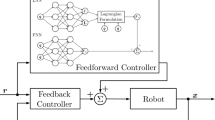Abstract
Since learning models from data allows direct and accurate model approximation, it has lately become a tool of increasing interest in robotics. However, most learning methods require significant amounts of samples in the anticipated region to achieve adequate performance. In this paper, a novel modeling framework via sparsity and feature learning (SFL) is proposed for approximating multi-DOF manipulator inverse dynamics. A large number of features and their weights are recognized and selected from the analytical form of the dynamical equation. A matrix-free procedure based on the Alternating Direction Multiplier Method (ADMM) and reweighted L1-minimization technique are presented for time and space efficiency. Finally, we conducted the torque prediction and control experiments on a 7-DOF industrial robot to show the effectiveness of the proposed learning framework and compared the performance with different model classes and procedures. Superior to existing modeling methods, the merits of our method are that it needs no prior knowledge of the mechanical parameters of the robot thus avoiding modeling and assembly errors introduced by the geometric parameter identification procedure. Moreover, as the restriction of the features with specific forms is viewed as a strong priority of learning, the SFL method outperforms the universal approximation method on real data while generalizing for finite training samples.
Similar content being viewed by others
Explore related subjects
Discover the latest articles and news from researchers in related subjects, suggested using machine learning.References
Haddadin, S., De Luca, A., Albu-Schäffer, A.: Robot collisions: a survey on detection, isolation, and identification. IEEE Trans. Robot. 33(6), 1292–1312 (2017)
Nakanishi J, Cory R, Mistry M, Peters J, Schaal S: Comparative experiments on task space control with redundancy resolution. In: 2005 IEEE/RSJ International Conference on Intelligent Robots and Systems. pp. 3901–3908 (2005)
Song, G., Huang, R., Qiu, J., Cheng, H., Fan, S.: Model-based control with interaction predicting for human-coupled lower exoskeleton systems. J. Intell. Robot. Syst. 100(2), 389–400 (2020)
Jubien, A., Gautier, M., Janot, A: Dynamic identification of the Kuka LightWeight robot: Comparison between actual and confidential Kuka's parameters. In: IEEE/ASME International Conference on Advanced Intelligent Mechatronics. pp. 483–488. (2014)
Atkeson, C.G., An, C.H., Hollerbach, J.M.: Estimation of inertial parameters of manipulator loads and links. The International Journal of Robotics Research. 5(3), 101–119 (1986)
Seeger, G., Leonhard, W: Estimation of rigid body models for a six-axis manipulator with geared electric drives. In: 1989 IEEE International Conference on Robotics and Automation. pp. 1690–1691 (1989)
Swevers, J., Ganseman, C., Tukel, D.B., De Schutter, J., Van Brussel, H.: Optimal robot excitation and identification. IEEE transactions on robotics and automation. 13(5), 730–740 (1997)
Swevers, J., Verdonck, W., Naumer, B., Pieters, S., Biber, E.: An experimental robot load identification method for industrial application. The International Journal of Robotics Research. 21(8), 701–712 (2002)
Afrough, M., Hanieh, A.: A: identification of dynamic parameters and friction coefficients. J. Intell. Robot. Syst. 94(1), 3–13 (2019)
Zhang, L., Wang, J., Chen, J., Chen, K., Lin, B.: Xu, F: dynamic modeling for a 6-DOF robot manipulator based on a centrosymmetric static friction model and whale genetic optimization algorithm. Adv. Eng. Softw. 135, 102684 (2019)
Brunot, M., Janot, A., Young, P.C., Carrillo, F.: An improved instrumental variable method for industrial robot model identification. Control. Eng. Pract. 74, 107–117 (2018)
Xu, T., Fan, J., Chen, Y., Ng, X., Ang, M.H., Fang, Q., Zhao, J.: Dynamic identification of the KUKA LBR iiwa robot with retrieval of physical parameters using global optimization. IEEE Access. 8, 108018–108031 (2020)
Gautier, M., Khalil, W.: Exciting trajectories for the identification of base inertial parameters of robots. The International journal of robotics research. 11(4), 362–375 (1992)
Jia, J., Zhang, M., Zang, X., Zhang, H., Zhao, J.: Dynamic parameter identification for a manipulator with joint torque sensors based on an improved experimental design. Sensors. 19(10), 2248 (2019)
Peters, J., Schaal, S.: Learning to control in operational space. The International Journal of Robotics Research. 27(2), 197–212 (2008)
Vijayakumar, S., D'souza, A., Schaal, S.: Incremental online learning in high dimensions. Neural computation. 17(12), 2602–2634 (2005)
Scholkopf, B., Smola, A.J.: Learning with kernels: support vector machines, regularization, optimization, and beyond. Adaptive Computation and Machine Learning Series. (2018)
Zhao, Y.P., Li, B., Li, Y.B., Wang, K.K.: Householder transformation based sparse least squares support vector regression. Neurocomputing. 161, 243–253 (2015)
Onozato, K., Maeda, Y: Learning of inverse-dynamics and inverse-kinematics for two-link scara robot using neural networks. In SICE Annual Conference pp. 1031–1034 (2007)
Kumpati, S.N., Kannan, P.: Identification and control of dynamical systems using neural networks. IEEE Trans. Neural Netw. 1(1), 4–27 (1990)
Nguyen-Tuong, D., Seeger, M., Peters, J: Computed torque control with nonparametric regression models. In 2008 American Control Conference pp. 212–217 (2008)
Snelson, E., Ghahramani, Z.: Sparse Gaussian processes using pseudo-inputs. Adv. Neural Inf. Proces. Syst. 18, 1257 (2006)
Meier, F., Hennig, P., Schaal, S: Efficient Bayesian local model learning for control. In 2014 IEEE/RSJ International Conference on Intelligent Robots and Systems pp. 2244–2249 (2014)
Zhou, N., Xu, Y., Cheng, H., Fang, J., Pedrycz, W.: Global and local structure preserving sparse subspace learning: An iterative approach to unsupervised feature selection. Pattern Recogn. 53, 87–101 (2016)
Zhao, Y., and Vela, P. A: Good feature selection for least squares pose optimization in VO/VSLAM. In: 2018 IEEE/RSJ International Conference on Intelligent Robots and Systems, pp. 1183–1189 (2018)
Cavestany, P., Rodriguez, A. L., Martinez-Barbera, H., Breckon, T. P: Improved 3D sparse maps for high-performance SFM with low-cost omnidirectional robots. In: 2015 IEEE International Conference on Image Processing. pp. 4927–4931 (2015)
Abiantun, R., Juefei-Xu, F., Prabhu, U., Savvides, M.: SSR2: sparse signal recovery for single-image super-resolution on faces with extreme low resolutions. Pattern Recogn. 90, 308–324 (2019)
Spong, M. W., and Vidyasagar, M: Robot dynamics and control. John Wiley & Sons. (2008)
Craig, J.: J: introduction to robotics: mechanics and control, 3/E. Pearson Education India. (2009)
Tomei, P.: A simple PD controller for robots with elastic joints. IEEE Trans. Autom. Control. 36(10), 1208–1213 (1991)
Kelly, R., Davila, V. S., Perez, J. A. L; Control of robot manipulators in joint space. Springer Science & Business Media (2006)
Tibshirani, R.: Regression shrinkage and selection via the lasso. J. R. Stat. Soc. Ser. B Methodol. 58(1), 267–288 (1996)
Slyusar, V. I: Analytical model of the digital antenna array on a basis of face-splitting matrixs product. In ICATT’97-II International Conference on Antenna Theory and Techniques (2015)
Jin, J., Gans, N.: Parameter identification for industrial robots with a fast and robust trajectory design approach. Robot. Comput. Integr. Manuf. 31, 21–29 (2015)
Khalil, W., Gautier, M., Lemoine, P: Identification of the payload inertial parameters of industrial manipulators. In Proceedings 2007 IEEE International Conference on Robotics and Automation, pp. 4943–4948 (2007)
Makkar, C., Dixon, W. E., Sawyer, W. G., and Hu, G: A new continuously differentiable friction model for control systems design. In Proceedings, 2005 IEEE/ASME International Conference on Advanced Intelligent Mechatronics, pp. 600–605 (2005)
Papadopoulos, E.G., Chasparis, G.C.: Analysis and model-based control of servomechanisms with friction. J. Dyn. Syst. Meas. Control. 126(4), 911–915 (2004)
Agrawal, A., Verschueren, R., Diamond, S., Boyd, S.: A rewriting system for convex optimization problems. Journal of Control and Decision. 5(1), 42–60 (2018)
Boyd, S., Parikh, N., Chu, E: Distributed optimization and statistical learning via the alternating direction method of multiplier (2011)
Candes, E.J., Wakin, M.B., Boyd, S.: P: enhancing sparsity by reweighted ℓ 1 minimization. J. Fourier Anal. Appl. 14(5), 877–905 (2008)
Meurer, A., Smith, C.P., Paprocki, M., Čertík, O., Kirpichev, S.B.: Rocklin, Scopatz, a: SymPy: symbolic computing in Python. PeerJ Computer Science. 3, e103 (2017)
Eckstein, J., Bertsekas, D.P.: On the Douglas—Rachford splitting method and the proximal point algorithm for maximal monotone operators. Math. Program. 55(1), 293–318 (1992)
Nishihara, R., Lessard, L., Recht, B., Packard, A., Jordan, M: A general analysis of the convergence of ADMM. In International Conference on Machine Learning pp. 343–352 (2015)
Schröer, K., Albright, S.L., Grethlein, M.: Complete, minimal and model-continuous kinematic models for robot calibration. Robot. Comput. Integr. Manuf. 13(1), 73–85 (1997)
Mao, C., Chen, Z., Li, S., Zhang, X.: Separable nonlinear least squares algorithm for robust kinematic calibration of serial robots. J. Intell. Robot. Syst. 101(1), 1–12 (2021)
Swevers, J., Ganseman, C., De Schutter, J., Van Brussel, H.: Experimental robot identification using optimised periodic trajectories. Mech. Syst. Signal Process. 10(5), 561–577 (1996)
Dong, Y., Ren, T., Chen, K., Wu, D: An efficient robot payload identification method for industrial application. Industrial Robot: An International Journal (2018)
An, C. H., Atkeson, C. G., and Hollerbach, J. M: Estimation of inertial parameters of rigid body links of manipulators. In: 24th IEEE Conference on Decision and Control. pp. 990–995 (1985)
Rasmussen, C. E: Gaussian processes in machine learning. In: Summer school on machine learning. pp. 63–71 (2003)
Vijayakumar, S., D'souza, A., Shibata, T., Conradt, J., Schaal, S.: Statistical learning for humanoid robots. Auton. Robot. 12(1), 55–69 (2002)
Song, Z., Yi, J., Zhao, D., Li, X.: A computed torque controller for uncertain robotic manipulator systems: fuzzy approach. Fuzzy Sets Syst. 154(2), 208–226 (2005)
Tabatabaian, M.: Engineering systems dynamics modelling, simulation, and design. British Columbia Institute of Technology. (2021)
Author information
Authors and Affiliations
Corresponding author
Additional information
Publisher’s Note
Springer Nature remains neutral with regard to jurisdictional claims in published maps and institutional affiliations.
Rights and permissions
About this article
Cite this article
Yu, C., Li, Z., Yang, D. et al. Physical-Parameter-Free Learning of Inverse Dynamics for Multi-DOF Industrial Robots via Sparsity and Feature Learning. J Intell Robot Syst 105, 53 (2022). https://doi.org/10.1007/s10846-022-01633-0
Received:
Accepted:
Published:
DOI: https://doi.org/10.1007/s10846-022-01633-0
Keywords
Profiles
- Chenglong Yu View author profile




